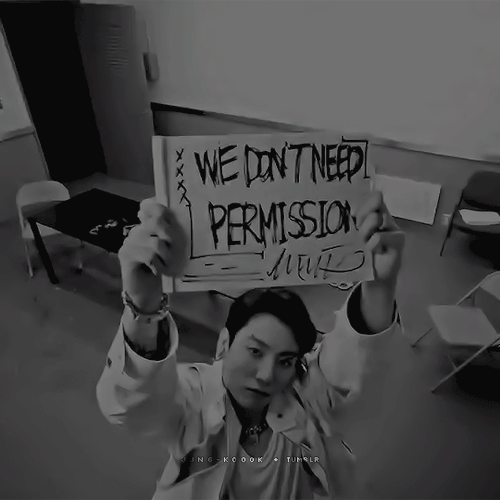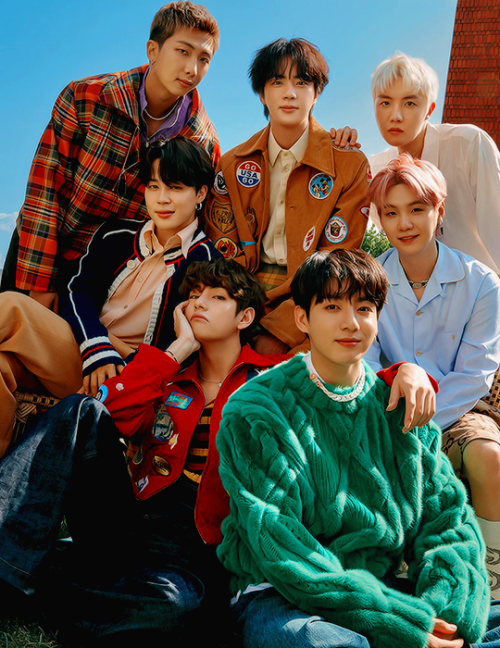BTS, Davichi, AOA, NCT, Red Velvet, Apink, SF9, EXID...
424 posts
Giuliawritesanddoeskpop - Coreianando - Tumblr Blog
two very good fictional relationship dynamics:
1. i would find you and love you in every universe. our love is inevitable and transcends reality as we understand it
2. this is the only universe where the dominos fell exactly right so that we could fall in love. we have something unique and we have overcome so much to get here

Pretentious thought of the day:
Writing is hard because you have to be both the composer and the orchestra.
Some people are flowing with imagination and creativity and can come up with brilliant, original stories, but can’t realise them as they’d like.
Some people have the talent to tell a story beautifully in a way that’s really pleasing to read, but they can only work off other people’s ideas.
In most other media, music or film or whatever, the roles are split out. You can be one part of the process, and rely on other people with different skills to carry it on. But when you write, you’re expected to have all of the skills yourself. You’re the composer and the conductor and the orchestra. You’re the screenwriter and the director and the cast. You come up the vision, and you have to execute it.
That’s tough.






jungkook’s gq interview ♡
Hi. I hate filler scenes, they drive me up the wall BUT i'm currently drafting one of my stories and notice that it needs a filler scene. Do you have any advice on how to make filler scenes feel less like they are a waste of words and feel more like they belong in the story?
How to Fix Your Filler Scenes

The whole reason a scene would be considered "filler" was if it offered no contribution whatsoever to plot, worldbuilding, or character development within the narrative. Filler takes up space, can make the pacing drag, and often adds quantity but not quality to your story.
You never want ANY 100% filler scenes in your work, especially if you plan on publishing traditionally and need to keep your word count down, and unfortunately, there aren't many exceptions to this.
However, a lot of people rely heavily on filler to provide a segue into the next part of their story and keep the pacing steady, so in that case, how do you make these filler scenes worthwhile?
Here are some ways to fix your filler scenes to make them meaningful (and essential) to the story!
1. Make it About The Characters and Their Relationships

A good way to make a scene not filler is if you use it to help develop your characters or the relationships between them.
Maybe you can use this time to make your protagonist and their love interest grow closer, or maybe you could use it to reveal some backstory that you weren't sure where to piece into the narrative beforehand.
Maybe your protagonist has a revelation about themselves or about the others in their group, whether through a meaningful conversation or by observing their behavior.
This could be a good time to show how your characters view the world around them, having philosophical conversation about love or death or anything in between, or to show them changing their views based on their experiences and the experiences of others.
All in all, if you make your scene an important aspect of your story when it comes to character development, then it's not filler at all, and will serve the story well in not only connecting two important events, but also allowing the reader to learn more about the people they've invested in.
2. Make it About the Worldbuilding

Worldbuilding is an important part of any story, especially in high fantasy and Sci-Fi. If you need to take a break from your plot in order to make sure things aren’t going by too fast, perhaps take some time to develop the world that your characters live in.
Now, I’m not saying to use this time to infodump everything there is about your character’s world, but instead show it off in a beautiful and poignant scene that can be coupled with character development.
It’s the night before a big event. The lovers sneak out of the motel to enjoy a drink at the bar at the far edge of the intergalactic satellite they’ve docked at to refuel. Perhaps while drunk, one of the characters reveals something about their past they’d meant to keep hidden?
A character takes their foreign friend shopping in a bazaar unlike anything you’ve ever scene before. Perhaps they find an item of interest there that helps them along their journey?
These scenarios make sure that the “filler” is actually an important aspect of the story that would actually take away from the overall quality if it were removed.
3. Make it About Suspense

It's night. The sun is going down. The fire crackles and sputters.
Tomorrow, the characters will be off to battle. They know that they might be sitting in a room with people who will be dead by the following evening. They wonder if this will be the last time they see each other alive, if this will be the last conversations they ever have while they're all in one piece.
Suspense is a great way to make your filler scene important, building up the tension leading up to the next scene. Of course, this scene can only be used to segue into a very, very integral moment in the story, perhaps even the climax, so use it wisely.
Suspenseful scenes often benefit from an interesting setting and high-tension description and dialogue, and can also be paired with character development to show how your protagonists react in the face of fear.
4. Understand that Sometimes Cutting the Scene May Be For the Best

Sometimes, things just don't work out with the above ideas. Perhaps it's too late in the story to develop characters or worldbuilding, or maybe the subsequent event isn't important enough to prompt an entire scene dedicated to suspense.
In that case, it's probably best to just cut the filler scene. To keep from the timeskip being weird, have the event you want to segue into be at the beginning of a new chapter, or maybe re-work the narrative so that it weaves together more easily.
It'll be difficult to do this, especially if you've grown attached to what you've written, but I promise it'll work out all the better in the end; each aspect of the story is supposed to mean something, and I wouldn’t want you to put in all that effort and time into crafting a scene that, in the end, doesn’t really do much for the narrative.
Hope this helped, and happy writing!





mesmerising in every possible way.
[psd cr. @honsool] [cr.namuspromised]










#HAPPYJINDAY








just a reminder jungkook said “out of all the vcrs that i’ve seen, this one is the best.” for anon ♡
How to Get Out of A Writing Slump

Feeling a writing slump approaching you and your story? Get ready for some tips by guest writer Aamna to help get you focused and ready to continue your writing goals.
So writing slumps. Wow! Isn’t that a big can of worms? This little curse can descend upon a writer, no matter a beginner or published when they least expect it. And for several reasons. The most common instance can be when you are right in the middle of a story or a first draft. So here are some methods that I have come across in my writing journey, and have seen work really well for either myself or others.
1) Take a break from your current project. Let your subconscious do the processing.
Sometimes you’re just not feeling your current project. How do get your heart back into it again? Drop it and do something else. What I would recommend doing in this situation is, write a short story. Or a poem. Or fanfic. It doesn’t have to be related to your WIP. It will get your conscious mind out of a rut, but it’ll still be processing in the back of your brain, and later when you come to your novel, Voila! You have a fresh set of eyes and renewed vigor for your story.
2) There’s a reason NaNoWriMo has pep talks.
By far, the thing that has worked for me the most is listening to other writers speak. Even if it is just a writing buddy and not a published author, there is something truly magical about listening to a storyteller gush about their story with the passion of a hero ready to save the world. The incessant urge to create something just as beautiful or being on that high of imagination that washes over me as I listen to them has worked for me several times when I feel myself falling into a slump.
Go through the NaNoWriMo pep talks, listen to author interviews or podcasts, or find a writing buddy. Remind yourself how fun it is to write.
3) Go back to the synopsis of your story to see what made you excited to write that in the first place. Rejuvenate the love!
I have personally seen that doing this little can trick can give you that dose of motivation you need to get back into a story. It takes you back to that place when you loved that idea and gets you excited to work on it again.
My ideas come to me in the form of something like a Goodreads synopsis, so whenever I want to get back to working on it again after a break (maybe because of upcoming exams or tests), I have seen that going through the “hook”, helps to re-ignite that love and excitement about the idea.
4) Make a mood board or playlist for your characters or setting.
A writing slump may not necessarily be a complete turn-off from working on a story. It can also be that you are just in a position that you are not able to get the words out, but that doesn’t mean the only way to effectively work is ‘words.’
Creating aesthetics and playlists can be a very fun, entertaining exercise to do, and make the writing process seem less like a chore.
5) Allow yourself the break. Don’t push yourself back into writing full-length novels or projects.
Every time you take a break from writing does not have to be called a writing slump. Sometimes it’s way better to take a mental health break, or just put a pause for no other reason that you don’t want to, and you’d rather work on something else.
You should know when to shelve a story or let a project go. It’s completely okay to stop in the middle of a WIP and delve into a new idea instead of forcing yourself to brainstorm and drag yourself through a story that you are not interested in anymore. A lot of the time that’s exactly what pushes you into a slump in the first place.
6) Remove the pressure. Don’t let perfectionism hold you back.
Editing as you write is not the most advisable course of action, especially when you’re a new writer. And fretting about things like sentence structure, word choice, or minute grammar errors shouldn’t be the focus while you’re writing. The first draft of anything is a mess. This is when you should turn off your inner editor, and let your perfectionist inner-self take a back seat. Little things like these, even though you may not realize it, do a lot to demotivate you and take the away joy of writing because you feel that nothing you write is ever good enough. Don’t compare yourself to published authors. Their books have gone through developmental edits, copy edits, beta readers, and whatnot.
Constantly expecting and beating yourself up for not being as good as someone else can push you into a slump faster than a boring story.
Aamna (she/her) is a young devourer of books, stories, and any other form of words you can give her. More often than not, you can find her either reading, daydreaming about her seemingly never-ending WIP, or working on her blog. She likes to say that words are her superpower, and has a weird obsession with Marvel, ice cream, really bad art journaling, and Scrabble. She lives in India and is currently working on a Turkish-inspired fantasy novel. You can also follow her on IG.
Top Photo by Ryan Snaadt on Unsplash




gamer boyfriend strikes again 😍
Crafting A Fantasy Culture, or the fallacies of using culture in the singular
The world is an interdependent place.
A lot of Western writers will look at the need to diversify their writing and try to cherry pick outside cultures to add. They then come to us with a laundry list of questions about what they’re allowed to change about those cultures because, well, they didn’t pull from a broad enough context.
The thing about researching individual cultures is: you’re never going to be researching just one culture. You’re going to be researching all the cultures they interacted with, as well.
Cultures are made by interacting with other cultures. So you can’t simply plop a singular culture into a fantasy world and expect it to work. There is too much outside influence on that culture for you to get a holistic picture by researching the culture in isolation.
Instead, you need to ask yourself, “what environments made them, and how much of their surrounding contexts do I need to add to my fantasy world to make this genuine respectful representation?”
And before you say that you can’t possibly do that, that is too much research, let me introduce you to the place you’re already doing it but don’t realize:
Stock Fantasy World 29
Aka, fantasy Europe.
It gets ragged on a lot, but let’s take a minute to look at the tropes that build this stock fantasy world.
Snow
4 seasons
Boars, pigs, wolves, dogs, pine trees, stone
Castles
Sheep
Knights
A king
Farming based economy
Religion plays a pretty big role in life
All fairly generic fantasy Europe tropes. But if you look more closely, you’ll notice that this is painting a picture of Fantasy Germany/the Netherlands, with perhaps a dash of France and/or England in there, all of it vaguely Americanized (specifically the New England area) because there’s usually potatoes and tomatoes. The geographic region is pretty tight, and it just so happens to mesh with the top three superpowers of upper North America, and arguably the English speaking world.
But let’s keep going.
They import stuff. Like fine cloth, especially silk, along with dyes & pigments
These things are expensive from being imported, so the nobility mostly have them
There’s usually a war-mongering Northern People invading places
If brown people exist they are usually to the East
There might be a roaming band of nomadic invaders who keep threatening things
There is, notably, almost no tropical weather, and that is always to the South if it’s mentioned
There might be an ocean in the South that leads to a strange forgien land of robed people to survive a desert (or did I just read too much Tamora Pierce?)
And, whoops, we have just accidentally recreated European history in its full context.
The Northern people are Norse, and their warring ways are indicative of the Viking Invasion. The imports hint at Asia, namely the Ottomans and India, and the silk road. The roaming invaders are for Mongolian Khanate. The ocean and tropical weather in the South hints at Spain, Greece, and the Mediterranean. And the continent of robed people indicates North Africa, and/or Southwest Asia.
Suddenly, stock fantasy world 29 has managed to broad-strokes paint multiple thousands of years of cultural exchange, trade, wars, invasions, and general history into a very small handful of cultural artifacts that make up throwaway lines.
Europe As Mythology And You
European history is what’s taught in Western classrooms. And a lot of European history is painted as Europe being a cultural hub, because other places in the world just aren’t talked about in detail—or with any sort of context. Greece and Rome were whitewashed; the Persian and Ottoman empires were demonized; North Africans became the enemy because of their invasion of Spain and the fact many of them were not-Christian; the Mongolian Khanate was a terrible, bloodthirsty culture whose only goal was destruction.
But because all of these parts did interact with Europe and were taught in history class, writers crafting a fantasy Europe will automatically pull from this history on a conscious or subconscious level because “it’s what makes sense.”
The thing is, despite people writing European fantasy subconsciously recreating European history, they don’t actually recreate historical reality. They recreate the flattened, politically-driven, European-supremacist propaganda that treats every culture outside of Europe as an extra in a movie that simply exists to support Europe “history” that gets taught in schools.
As a result of incomplete education, a lot of people walk away from history class and believe that cultures can be created in a vacuum. Because that’s the way Europe’s history was taught to them.
Which leads to: the problem with Fantasy World 29 isn’t “it’s Europe.” It’s the fact it’s an ahistorical figment of a deeply colonial imagination that is trying to justify its own existence. It’s homogeneous, it only mentions the broader cultural context as a footnote, it absolutely does not talk about any people of colour, and there’s next to no detailing of the variety of people who actually made up Europe.
So writers build their Fantasy World 29 but they neglect the diversity of religion and skin tone and culture because it’s unfamiliar to them, and it was never taught to them as a possibility for history.
While “globalization” is a buzzword people throw around a lot to describe the modern age, society has been global for a large portion of human history. There were Japanese people in Spain in the 1600s. Polynesians made it to North America decades if not centuries before Columbus did. There are hundreds more examples like this.
You can absolutely use fantasy to richen your understanding of Europe, instead of perpetuating the narratives that were passed down from victor’s history. People of colour have always existed in Europe, no matter what time period you’re looking at, and unlearning white supremacist ideas about Europe is its own kind of diversity revolution.
Travel is Old and People Did It Plenty
Multiculturalism is a tale as old as time. And while some populations were very assimilationist in their rhetoric, others were very much not. They would expand borders and respect the pre-existing populations, or they would open up networks to outsiders to become hubs of all the best the world had to offer. Even without conscious effort, any given place was building off of centuries of human migration because humans covered the globe by wandering around, and people have always been people.
Regardless, any time you have a group of people actively maintaining an area, they want to make travelling for themselves easier. And the thing about making travelling for yourself easier is: it made travel for outsiders just as possible. By the time you reach the 1200s, even, road, river, and ocean trade networks were thriving.
Sure, you might be gone for a year or three or five because the methods were slow, but you would travel. Pilgrimages, trade routes, and bureaucratic administrative routes made it possible for people to move around.
And also, soldiers and war did really good jobs of moving people around, and not all of them went back “home.” Hence why there have been African people in England since the Roman empire. When you have an empire, you are going to take soldiers from all over that empire; you aren’t going to necessarily pull from just the geographic region immediately surrounding the capital.
Yes, the population that could travel was smaller than it is now, because land needed to be worked. But Europe isn’t the be all end all in how much of its population needed to be in agriculture in order to function; the Mughals, for example, had 80% of their population farming, compared to over 90% for Europe in the same time period. That’s an extra 10% of people who were more socially free to move around, away from their land. Different cultures had different percentages of people able to travel.
This isn’t counting nomadic populations that relied on pastoralism and horticulture who didn’t actually settle down, something a lot of history tends to ignore because cities are easier to discuss. But nomadic populations existed en masse across Eurasia, and they took cultural traditions all over the continent.
Just because it wasn’t fast doesn’t mean it didn’t happen. And just because a lot of Europeans couldn’t travel because of the agricultural demands of the continent, doesn’t mean every other culture was as tied to settlements.
Multiculturalism and Diffusion
While each individual culture is unique, and you can find pockets of difference anywhere, cultures exist on a sliding scale of broad customs across the globe. Greece and Turkey will have more in common than China and England, because the trade routes were much closer and they shared central rulership for multiple hundreds of years.
This is why we keep saying it’s important to keep cultures with other cultures close to them. Because those are the natural clusters of how all of the cultures involved would be formed. The proper term for this is cultural diffusion, and it happened all the time. Yes, you could get lots of people who had their own unique customs to set themselves apart. But they had the same natural resources as the dominant group, which meant they couldn’t be completely and totally alien.
Even trade influence wouldn’t produce the same results in two places. When Rome imported silks from China, they rewove them to be a different type of fabric that was lighter and more suited to their climate. Then the Romans sold the rewoven silk back to China, who treated it differently because they’d woven it the first way for a reason. They didn’t talk to each other directly because of how the Silk Road was set up at the time, either, so all they had were the goods.
And people automatically, subconsciously realize this whenever they write Fantasy World 29. They put like cultures with like cultures in Europe. Because even if they weren’t really taught to see the rest of the world as anything more than a footnote, they still transfer those footnotes to their fantasy.
The problem is, people don’t realize the gradient of customs. In the modern day, Greece and Turkey are different countries, with histories that are taught in totally different frameworks (Greece as an appropriated white supremacist “ancient land” that all Western European societies are descendent from, Turkey as a land of brown people that were Muslim and therefore against the Good Christian Europe), so it’s really easy to ignore all of their shared history.
People often fought for the right to rule (or even exist) in a place, which deeply impacted the everyday people and government. Ancient Persia is a fantastic example of this, because it covered huge swaths of land and was a genuinely respectful country (it took over a deeply disrespectful country); had it not been for Cyrus the Great deciding that he would respect multiculturalism, the Second Temple wouldn’t have been rebuilt in Jerusalem.
You can’t homogenize an area that was never homogenous to begin with. Because there was a ton of fighting and sometimes centuries-old efforts to preserve culture in the face of all this fighting (that sometimes came with assimilation pressure). Dominant groups, invading groups, influencing groups, and marginalized groups have always existed in any given population. See: Travel is Old above. See: people have always been people and wandered around. Xenophobia is far, far older than racism ever will be, because xenophobia is simply “dislike of Other” and humans love crafting “us vs them” dynamics.
This lack of unity matters. It’s what allows you to look at a society (especially one with a centralized government) and see that it is made up of people that are different. It leads you to asking questions such as:
Who was persecuted by this group?
Did the disliked group of people exist within their borders, or were they driven away and are now enemy #1?
What was their mindset on diversity?
How did they handle others encroaching on what they saw as their territory?
People do different things across different households, let alone hundreds of miles away. You wouldn’t expect someone from a rich, white area of California to behave the same way as someone from a middle-class immigrant neighbourhood from NYC. I’m sure, if you looked at your own city, you would scoff at the concept of someone mistaking your city for one five hours away, because when you know them, they’re so different.
So why do you expect there to be only one type of person anywhere else?
Cultural and Geographic Context Matters
A region’s overreacting culture (either determined by groups of people who mostly roam the land, or a centralized government) and their marginalized cultures determine the infighting within a group, even if the borders remain the same.
Persecution and discrimination are just as contextual as culture. Even if the end result of assimilation and colonialism was the same, the expectations for assimilation would look different, and what they had been working with before would also look different. You can’t compare Jewish exile from various places in Europe with Rromani exiles in Europe, and you definitely can’t compare them with the Hmong in Southeast Asia. They came from different places and were shaped by different cultures.
A culture that came from a society that hated one particular aspect of them will not form—at all—if they’re placed in a dominant culture that doesn’t find their cultural norms all that persecution-worthy. And the way they were forced to assimilate to survive will play into whatever time period you’re dealing with, as well; see the divide of Jewish people into multiple categories, all shaped by the resources available in the cultures they stayed in the longest.
You can’t remove a culture’s context and expect to get the same result. Even in a culture that doesn’t wholesale have an assimilationist agenda, you can still get specific prejudices and scapegoats that happen when there’s a historical precedent in the region for disliking a certain group.
Once you start cherry picking what elements of a culture to take—because you’ve plunked the !Kung into Greece and need to modify their customs from the desert to a tropical destination —you’re going to end up with coding that is absolutely positively not going to land.
Coding is a complex combination of foods, clothing, behaviour/mannerisms, homes, beliefs, and sometimes skin tone and facial features. A properly coded culture shouldn’t really need any physical description of the people involved in order to register as that culture. So when you remove the source of food, clothing, and home-building materials… how can you code something accurately from that?
And yes, it’s intimidating to think of doing so much research and starting from 0. You have to code a much larger culture than you’d originally intended, and it absolutely increases the amount of work you have to do.
But, as I said, you are already doing this with Europe. You’re just so familiar with it, you don’t realize. You can get a rundown of how to code the overarching culture with my guide: Representing PoC in Fantasy When Their Country/Continent Doesn’t Exist
Takeaways
Writers need to be aware of diversity not just as a nebulous concept, but as something that simply exists and has always existed. And the diversity (or lack thereof) of any one region is a result of, specifically, the politics of that region.
Diversity didn’t just exist “over there”. It has always existed within a society. Any society. All societies. If you want to start adding diversity into your fantasy, you should start looking at the edges of Fantasy World 29 and realize that the brown people aren’t just stopping at the designated border and trading goods at exactly that spot, but have been travelling to the heart of the place for probably a few hundred years and quite a few of them probably liked the weather, or politics, better so they’ve settled.
Each society will produce a unique history of oppressing The Other, and you can’t just grab random group A and put it in societal context B and expect them to look the same. Just look at the difference between the Ainu people, the anti-Indigenous discrimination they face, and compare it to how the Maori are treated in New Zealand and the history of colonialism there. Both Indigenous peoples in colonial societies on islands, totally different contexts, totally different results.
If random group A is a group marked by oppression, then it absolutely needs to stay in its same societal context to be respectful. If random group A is, however, either not marked by being oppressed within its societal context and/or is a group that has historically made that move so you can see how their situation changed with that move, then it is a much safer group to use for your diversity.
Re-learn European history from a diverse lens to see how Europe interacted with Africa and Asia to stop making the not-Europe parts of Fantasy World 29 just be bit parts that add flavour text but instead vibrant parts of the community.
Stop picking singular cultures just because they fascinate you, and place them in their contexts so you can be respectful.
~ Mod Lesya

A mini-guide on how to line edit! I’m gonna try and make a big long post later, but for those who don’t want to read a lot of words, here’s some quick tips!
What is line editing?
Line editing is a level of editing focusing on the sentences & paragraphs. It looks at the structure of each sentence to see if it’s conveying the idea the best it can. You want to upgrade the prose and clean up the text.
When do I do line editing?
After developmental (or “big picture”) editing, before copyediting (grammar & spelling). Don’t do line edits before you really workshop your piece, because you might end up getting rid of a lot of sections in developmental edits.
Ok, but Kels, what do I do?
Right, here are the quick-and-dirty line editing tips I use:
Use the “find” tool to search up your crutch words and get rid of them. These are words like: very, definitely, just, kind of, sort of, somewhat, somehow, maybe, enough, really, seem, sudden, guess, etc. etc. Everyone has different crutch words—I personally use “just” a LOT so I went and got rid of most of them! I tend to keep crutch words in dialogue to make it sound more natural, but up to you!
Look at your “that”s. Most of the time, a “that” in a sentence can be deleted. Read the sentence without the “that” and see if it makes sense. for example: “She told me that yesterday was her birthday.” vs “She told me yesterday was her birthday.” You can do without the “that” and it makes for cleaner, more concise writing!
(this is a pain BUT) read every sentence out loud. You might notice weird turns of phrase that you’d be better off changing, or clunky phrasing, missing words, weird pacing etc. if reading the WHOLE thing seems like A LOT (it is) do it one chapter or scene at a time and take a break! this will help u notice all of the weird small things that you just don’t pick up on while reading in your head
look at sentence structure! do you have a lot of long sentences? too many short sentences? a looooong paragraph of description that isn’t broken up? do a lot of your sentences start with the same word/phrase (like “He went upstairs / He called his mom / “Hi mom…” / He thought it was weird….” all in one paragraph, even with some other stuff between it?) make sure you’re changing up the composition so your readers dont get glossy-eyed!
read your dialogue out loud SEVERAL times. each time try for a new inflection. make sure it reads the way you want it to. make sure it sounds like something a real person would say. look at it again, and make sure it matches the character. make sure it’s not too heavy-handed or cliche or obvious to the theme.
look at your metaphors & similes. is there a better, more creative way you can say that?
word choice! word choice word choice word choice. this goes along with the reading aloud and metaphor bit, but pay close attention to the word choice. Are you using strong verbs/adjectives? was that an adverb you can get rid of? can you use one word there instead of two?
double check plot and character inconsistencies. this goes past just dialogue—look at actions & thoughts, too. while a lot of this might be caught in developmental edits, some stuff is bound to slip by. question EVERYTHING.
Some more resources:
Line Editing article | ShaelinWrites video | Alexa Donne video | Crutch Words list
best of luck, writers!


he’s so fine














bts for billboard magazine




jungkook - you quiz on the block